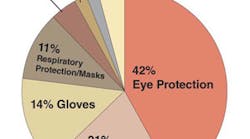In a survey conducted by the American Society of Safety Engineers and Kimberly- Clark Professionals, 98% of respondents observed someone in their organization failing to wear the required personal protection equipment (PPE) in a situation when that individual should have been wearing it.
Over the last three years, the sources say, the study has revealed consistent (if not worrisome) numbers concering noncompliance, rising from 85% in 2006, to 87% in 2007, to 89% in last year’s survey of 2008.
“Increasingly high noncompliance with PPE protocals is an alarming trend and a serious threat to worker health and safety,” said Gina Tsiropolous of Kimberly-Clark. “Whether this is a result of economic conditions, a flawed approach to safety programs, younger workers who are more inclined to take greater risks, or some other reason, it’s essential that workers wear PPE when it is required.”
Of the 132 individuals surveyed, 90% are safety directors or managers and the remaining 10% hold other positions responsible for purchasing, selecting, or influencing the purchase of PPE or industrial wiping solutions.
Eye protection was the ‘most challenging’ PPE category, a serious concern in that nearly three out of five workers who experience eye injuries were found not to be wearing any eye protection at the time of the accident. Each year, over 2,000 U.S. workers have a job-related eye injury that requires medical treatment and leaves some blinded. Hearing protection is another category that, if protocol is followed, could prevente 100% of noiseinduced hearing loss.
Safety professionals were asked what they had done to improve compliance levels, answering that their top choice was to improve existing education and training programs (67%). They also responded that increasing monitoring of employees (45%) and purchasing more comfortable PPE (39%) were among their top selections. Interestingly, 29% of respondants replied that they tie compliance to individual performance evaluations.
When asked what PPE suppliers could do to improve the compliance numbers, those surveyed selected “provide more comfortable PPE” as its number one answer (26%). Providing more instruction on the proper use (24%) followed, as did reducing prices (17%), providing greater size selection (12%), and offer more stylish PPE (8%) were also cited as options.
In addition to style and comfort, 87% replied that being able to customize the PPE products, would increase compliance. Climate-control features, or those providing cooling or warmth as needed, were also cited.










